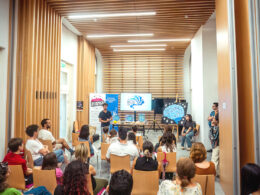In the run-up to the Malta Biennale, another workshop for children was held at Ħaġar Qim and Mnajdra Archaeological Park.
Titled Colour Adventures: Tent and Patterns, the workshop was led by Polish artist Wioletta Kulewska Akyel. Children aged eight and above delved into Akyel’s fascinating tent-like painting installation, which forms part of the main pavilion at maltabiennale.art. Adorned with stylised female figures, hand-painted texts and intricate patterns, the piece inspired lively discussions about its meaning, inspiration and process.
The children then collaborated on crafting an artwork tent of their own using red ochre pigment and gouache tempera paint on cotton canvas, which provided them with a unique opportunity not only to reflect on art and heritage but to actively engage in their own artistic pursuits.
Akyel’s artwork delves into one of the four main themes of maltabiennale.art: The Matri-archive of the Mediterranean.

Hosted at the Grand Master’s Palace and National Library in Valletta, this theme challenges patriarchal archiving norms by celebrating the creative contributions of Mediterranean women and providing a vital reinterpretation of historical narratives for generations to come.
The biennale’s three other main themes include Can You Sea?: The Mediterranean as a political body. Held at the Armoury in Vittoriosa, Dock-1 in Cospicua, and Underground Valletta, this theme highlights the sea’s pivotal role in shaping Malta’s identity and invites artists to explore the sea as a space that connects diverse realities across territorial constraints and continents.
The Counterpower of Piracy unfolds at St Elmo in Valletta, the Cittadella, Gozo Cultural Centre, and the Grain Silos in Gozo. This theme delves into Malta’s historical ties with piracy, drawing parallels to contemporary movements to portray piracy as a symbol of counterpower that inspires modern activists, hackers, and grassroots organisations.

The final theme, Decolonising Malta: Polyphony Is Us, explores Malta’s history of colonisation. Artworks showcased at the Main Guard, Tal-Pilar church and Auberge d’Aragon in Valletta together with Dock No.1 in Cottonera and Ġgantija Archaeological Park in Gozo aim to highlight the ongoing process of decolonisation by positioning Malta as a unique case that offers a vital perspective for the broader decolonial discourse.
Seventy local and international artists, including many of global renown, are currently putting the final touches on their installations for exhibition across 20 heritage sites in Malta and Gozo. The grand opening will be inaugurated by President George Vella, in the Throne Room of the Grandmaster’s Palace in Valletta on March 12.
maltabiennale.art is a Heritage Malta initiative through MUŻA, the Malta National Community Art Museum, in partnership with Arts Council Malta. maltabiennale.art is also presented in cooperation with the Ministries for Foreign and European Affairs and Trade, National Heritage, the Arts and Local Government, and Gozo, as well as with Visit Malta, Malta Libraries, MCAST, Festivals Malta, Valletta Cultural Agency and Spazju Kreattiv. With the participation of Malta School of Art, AUM, ŻfinMalta, KorMalta, Teatru Manoel, Malta Philharmonic Orchestra, Franco La Cecla, IULM University, Milan, Department of Humanities Studies, Faculty of Arts and Tourism, Underwater Department Heritage Malta, Archaeological Department Heritage Malta and Maritime Museum Heritage Malta.
For all the details, visit maltabiennale.art.
For more education-related stories, click here. For more Child stories, follow this link.










